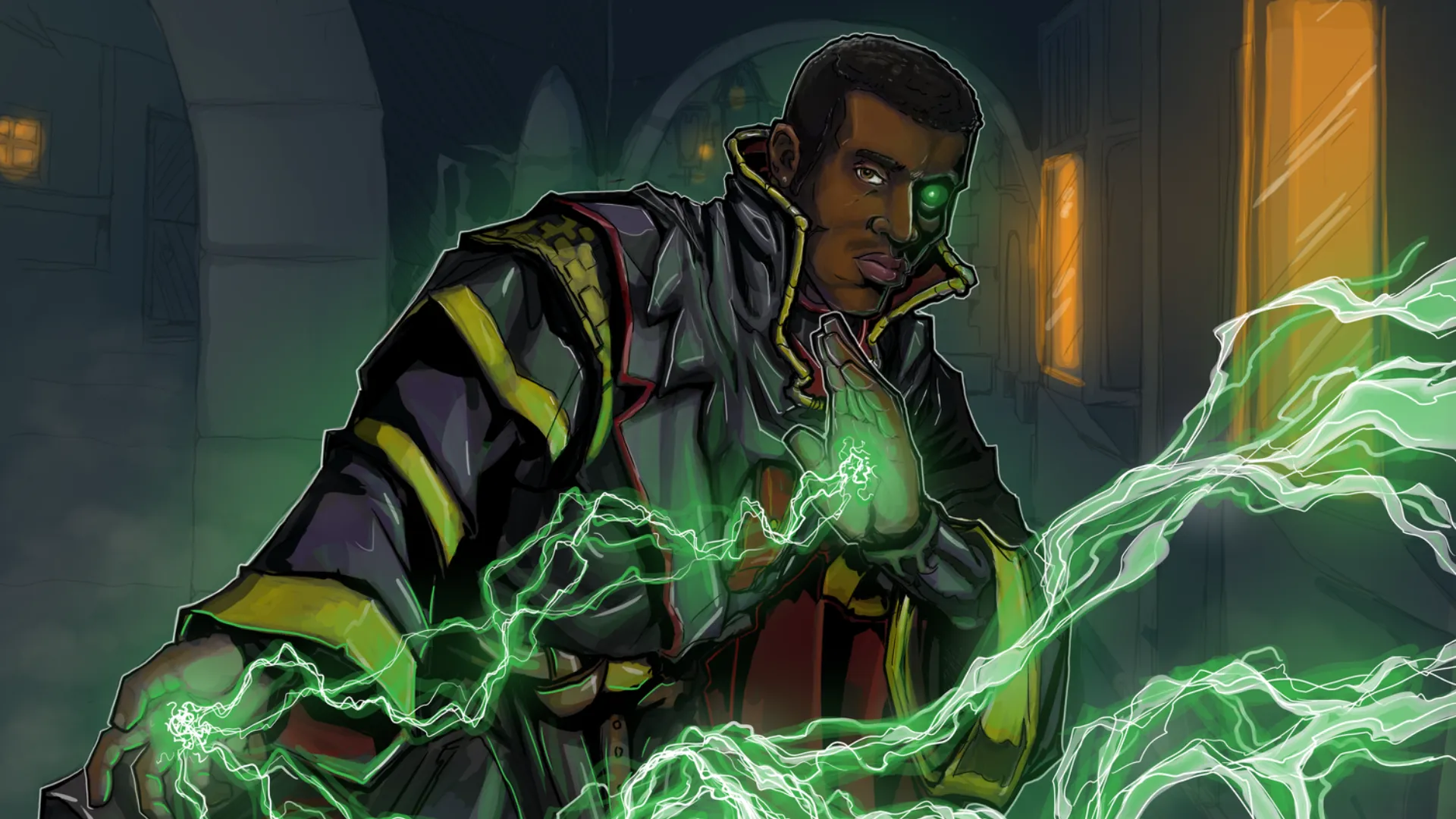Spell Sniper 5e is a powerful character archetype in Dungeons & Dragons that specializes in long-range spellcasting.
Whether you prefer to play as a sorcerer, wizard, or other magical class, this guide will help you become a master of long-range combat, allowing you to strike from a safe distance and take down foes before they even have a chance to get close to you.
In this guide, we’ll explore the benefits of playing as a Spell Sniper, provide tips and techniques for building and playing one effectively, and offer sample builds and troubleshooting advice to help you get the most out of your character. Whether you’re a seasoned D&D player or just starting out, this guide will help you take your spellcasting to new heights.
Spell Sniper 5e
Spell Sniper 5e is a character archetype in Dungeons & Dragons that specializes in long-range spellcasting. They have the ability to cast spells from a safe distance, which can be an incredibly powerful tool in combat. Spell Snipers are typically spellcasters such as sorcerers, wizards, or warlocks, but other classes can also use the Spell Sniper archetype.
Why play a Spell Sniper?
Playing as a Spell Sniper 5e can be a thrilling and rewarding experience in Dungeons & Dragons. The ability to attack from a distance means staying out of harm’s way while still dealing significant damage to enemies. This can be especially useful when facing dangerous opponents or in situations where melee combat is not an option. Additionally, the Spell Sniper archetype can be a great choice for players who prefer a more strategic approach to combat.
Benefits of spell sniper 5e
The Spell Sniper feat in Dungeons & Dragons 5e provides several benefits for spellcasting characters. These benefits can be game-changer in combat situations and can provide unique opportunities for creative problem-solving.
Increased Range for Spells
The primary benefit of Spell Sniper is the ability to cast spells at twice their normal range. This means that a spell that typically has a range of 60 feet can now be cast at up to 120 feet. This increased range can be especially useful for spells that require an attack roll, such as Eldritch Blast or Fire Bolt, as it allows you to stay further away from enemies while still being able to attack them.
The increased range can also be helpful for spells that have an area of effect, such as Fireball, as it allows you to target enemies from further away without putting your character in danger.
Ability to Ignore Cover
Another benefit of Spell Sniper is the ability to ignore cover when making spell attacks. This means that if an enemy is hiding behind a wall or other obstacle, you can still target them with your spell. This can be particularly useful when enemies use cover to avoid attacks, as it allows you to bypass their defenses and deal damage directly.
It’s important to note, however, that this benefit only applies to spells that require attack rolls. Spells that have a saving throw, such as Lightning Bolt or Cone of Cold, are not affected by the ability to ignore cover.
Cantrips
Cantrips are a type of spell in the Dungeons & Dragons 5th edition (D&D 5e) game that can be cast repeatedly without the need for rest or recovery. They are often referred to as “0-level spells” because they do not consume a spell slot when cast. Cantrips can be used by spellcasting classes, such as wizards, sorcerers, warlocks, clerics, and druids.
Cantrips are typically less powerful than higher-level spells, but they are useful for conserving resources and dealing consistent damage over time. Some cantrips have utility effects, such as creating light, producing a gust of wind, or mending objects.
In D&D 5e, spellcasters can choose a limited number of cantrips from their spell list, and they can learn additional cantrips as they gain levels. Some classes, such as warlocks, have access to a smaller selection of cantrips but can cast them at higher levels, making them more powerful.
It provides spellcasters with a versatile set of spells that can be used in a variety of situations without the need for rest or recovery, making them a valuable tool in any adventurer’s kit.
Cantrips That Can Be Yours Today
Certainly! Here is a detailed list of the cantrips that can be chosen when taking the Spell Sniper feat in D&D 5e:
- Eldritch Blast: Eldritch Blast is a popular choice for warlocks as it deals with force damage and can be enhanced with invocations. It also has a range of 120 feet, making it a great option for dealing damage from a safe distance. At higher levels, it can make multiple attacks.
- Fire Bolt: Fire Bolt is a ranged spell that deals fire damage. It has a range of 120 feet and can potentially ignite flammable objects and creatures, making it a useful option for dealing with enemies that are vulnerable to fire.
- Ray of Frost: Ray of Frost deals cold damage and has a range of 120 feet. It also reduces the target’s speed by 10 feet, making it a great option for slowing down enemies and making them easier to catch or escape from.
- Chill Touch: Chill Touch deals necrotic damage and prevents the target from regaining hit points. It has a range of 120 feet and can be useful for taking down tough enemies or preventing them from healing.
- Poison Spray: Poison Spray deals poison damage and has a range of 20 feet, which is doubled to 40 feet when taken with the Spell Sniper feat. While it has a shorter range than other cantrips, it can be useful for attacking enemies from a safe distance.
- Sacred Flame: Sacred Flame deals radiant damage and requires the target to make a Dexterity saving throw. It has a range of 60 feet, which is doubled to 120 feet with the Spell Sniper feat. This cantrip is a great option for dealing with enemies that have a high Armor Class (AC), as it requires a saving throw rather than an attack roll.
- Thorn Whip: Thorn Whip deals piercing damage and has a range of 30 feet, which is doubled to 60 feet with the Spell Sniper feat. It can also pull the target up to 10 feet closer, making it a great option for controlling the battlefield and positioning enemies.
Here is a table summarizing the cantrips available with the Spell Sniper feat:
| Cantrip Name | Damage Type | Range (ft) | Additional Effect |
| Eldritch Blast | Force | 120 | Multiple attacks at higher levels |
| Fire Bolt | Fire | 120 | Can ignite flammable objects/creatures |
| Ray of Frost | Cold | 120 | Reduces target’s speed by 10 ft |
| Chill Touch | Necrotic | 120 | Prevents target from regaining HP |
| Poison Spray | Poison | 40 | N/A |
| Sacred Flame | Radiant | 120 | Target makes Dexterity saving throw |
| Thorn Whip | Piercing | 60 | Can pull the target up to 10 ft closer |
These cantrips are not exclusive to characters with the Spell Sniper feat and can be learned by any spellcasting class. However, taking the feat provides an opportunity to choose a cantrip that can benefit from the increased range.
Which Cantrip is Best
It’s difficult to say which cantrip is objectively the “best” in Dungeons & Dragons 5th edition, as it often depends on the specific situation and the player’s individual preferences and playstyle. However, there are certainly some cantrips that are widely considered to be very powerful and useful.
Here are a few examples of cantrips that are often considered to be among the best in the game:
- Eldritch Blast: This warlock cantrip deals force damage and can be customized with invocations to add additional effects like pushing enemies back or pulling them towards you. It’s often considered one of the most powerful damage-dealing cantrips in the game.
- Toll the Dead: This necromancy cantrip deals damage to a single target, with the amount of damage increasing if the target is already injured. It’s a great choice for taking out tough enemies.
- Guidance: This divination cantrip gives a creature a bonus to one ability check of their choice. It’s a great way to give your allies a boost in situations where skill checks are important.
- Fire Bolt: This evocation cantrip deals fire damage to a single target at long range. It’s a reliable choice for ranged damage, especially against enemies weak to fire.
- Prestidigitation: This transmutation cantrip allows you to perform a variety of minor magical effects, such as creating a small illusion or flavoring food. While it doesn’t deal damage, it can be incredibly useful in non-combat situations.
Examples of Spell Sniper in Action
Spell Sniper can be a powerful feat in the right hands, and it can provide some exciting and unique opportunities for players to use their spells and abilities in creative ways. Here are a few examples of how Spell Sniper can be used in action:
Long-range spells: Spell Sniper allows you to double the range of your spells, which can be especially useful for long-range spells like Fireball, Lightning Bolt, or Cone of Cold. With the increased range, you can attack enemies from a safe distance, making it more difficult for them to retaliate.
Precise spells: Some spells require precise aims, such as Guiding Bolt or Ray of Frost. Spell Sniper can help you land these spells more accurately, which can be especially useful if you need to hit a specific target, such as an enemy spellcaster.
Combining spells: With Spell Sniper, you can also combine spells in interesting ways. For example, you could use the Eldritch Blast cantrip with the Agonizing Blast invocation to deal a significant amount of damage at long range. Alternatively, you could use the Create Bonfire cantrip to create a zone of fire and then use the Distant Spell meta magic to place it at a safe distance.
Crowd control: Spell Sniper can also be useful for spells that have a large area of effect, such as Entangle or Fear. With the increased range, you can affect more enemies and keep them at bay while your allies deal damage.
Sneak attacks: If you’re playing a rogue, Spell Sniper can be especially useful for delivering sneak attacks from long range. With the increased range, you can attack enemies from a safe distance and then use your cunning action to hide and avoid retaliation.
These are just a few examples of how Spell Sniper can be used in action. Ultimately, the best way to use Spell Sniper will depend on your character’s abilities, the situation you find yourself in, and your own creativity and ingenuity.
Drawbacks of Spell Sniper 5e
While the Spell Sniper 5e feat offers several benefits to spellcasters in D&D 5e, there are also some drawbacks that should be considered before taking the feat. Here are some of the main drawbacks to keep in mind:
Limited Utility:
While the increased range of spells is useful, it may not always be relevant in every combat encounter. Some battles may take place in smaller or more confined spaces, where long-range spells are less effective. Additionally, some spellcasters may have spells that do not benefit from increased range, making the feat less useful for those characters.
Delayed Benefits:
The Spell Sniper feat does not offer immediate benefits when it is taken, unlike some other feats that provide an increase to ability scores or a new ability right away. Instead, the feat only becomes useful when the character has access to spells that can benefit from the increased range. This can be a drawback for characters who are looking for immediate benefits or who may not get to higher levels of play where these spells are available.
Limited Spell Selection:
As mentioned earlier, the Spell Sniper feat only applies to spells that require an attack roll or that have a range of 5 feet or greater. This means that some spells, such as those that require a saving throw or that have a range of touch, are not eligible for the increased range. This can limit the spell selection for characters who take the feat.
Feat Tax:
In order to take the Spell Sniper feat, a character must have the ability to cast at least one spell. This means that characters who are not primarily spellcasters may need to invest in a level or two in a spellcasting class in order to qualify for the feat. This can be a drawback for characters who would prefer to invest in other abilities or who are already multiclassing.
Opportunity Cost:
Finally, the Spell Sniper feat comes at the cost of taking another feat that may be more beneficial to a character’s overall build. This opportunity cost means that characters must weigh the benefits of the Spell Sniper feat against other options that may be more useful in the long run.
The Spell Sniper feat offers an increased range for certain spells, but it also has several drawbacks to consider before taking it. These drawbacks include limited utility, delayed benefits, limited spell selection, feat tax, and opportunity cost. As with any feat, players should consider their character’s build and playstyle before deciding whether to take the Spell Sniper feat.
How to Take Spell Sniper
In D&D 5e, taking a feat like Spell Sniper is a way for characters to gain additional abilities or enhance their existing ones. Here’s a step-by-step guide on how to take the Spell Sniper feat:
Meet the Requirements
To take the Spell Sniper feat, a character must have the ability to cast at least one spell and be at least 4th level. This means that the character must have levels in a spellcasting class or have a racial trait that allows them to cast spells. If the character meets these requirements, they can move on to the next step.
Choose the Spell Sniper Feat
During character creation or whenever the character gains a new feat, the player can choose Spell Sniper as their new feat. This will give them access to the benefits of the feat, including increased spell range and the ability to learn one new cantrip.
Learn a New Cantrip
As part of the Spell Sniper feat, the character learns one new cantrip of their choice from the spellcasting class they have levels in. This cantrip can be chosen from any of the cantrips available to that class, and the character can cast it at will.
Enjoy Increased Spell Range
The primary benefit of the Spell Sniper feat is the increased range of certain spells. Once the feat is taken, the character’s spells that require an attack roll or that have a range of 5 feet or greater have their range doubled. This means that a spell with a range of 120 feet would now have a range of 240 feet.
It’s important to note that the Spell Sniper feat only applies to certain types of spells, as mentioned earlier. Spells that require a saving throw or have a range of touch are not affected by this feat.
Consider the Drawbacks
Before taking the Spell Sniper feat, it’s important to consider its drawbacks, which include limited utility, delayed benefits, limited spell selection, feat tax, and opportunity cost. Players should weigh these drawbacks against the benefits of the feat before making their decision.
Taking the Spell Sniper 5e feat can be a great way for characters to increase their spell range and gain additional cantrips. However, it’s important to consider the character’s build and playstyle before deciding to take this feat.
Races with Innate Magic
In D&D 5e, some races have innate magical abilities that allow them to cast spells or perform other magical feats without training or study. These races are often referred to as “magical races” and can be a great choice for players who want to play a character with magical abilities from the start of the game. Here are some races with innate magic abilities:
Tiefling: Tieflings are humans with fiendish ancestry, and as a result, they have a natural affinity for magic. They can cast the Thaumaturgy cantrip, and at higher levels, they gain access to spells like Darkness, Hellish Rebuke, and Scorching Ray.
Dragonborn: Dragonborn are a race of humanoid dragons, and as such, they have an innate connection to the magic of their draconic heritage. They can use their breath weapon, which is a magical ability that allows them to exhale a blast of elemental energy like fire, acid, or lightning.
Aasimar: Aasimar are humans with celestial ancestry, and as such, they possess a natural talent for magic. They can cast the Light cantrip and at higher levels, they can use their radiant soul ability to gain temporary hit points and deal extra radiant damage with their attacks.
Drow: Drow is a race of dark elves who possess innate magical abilities due to their connection to the Underdark. They can cast the Dancing Lights cantrip and at higher levels, they can use their innate spellcasting ability to cast spells like Darkness, Faerie Fire, and Levitate.
Genasi: Genasi are humans with elemental ancestry, and as such, they possess an innate connection to the elemental magic of their heritage. Depending on their subrace, they can have abilities such as the ability to cast the Create or Destroy Water cantrip or the ability to create a cloud of mist around themselves.
Gnome: Gnomes are a small race of humanoids known for their tinkering and magical abilities. They can cast the Minor Illusion cantrip and at higher levels, they can use their innate spellcasting ability to cast spells like Blur, Invisibility, and Major Image.
Half-Elf: Half-elves are a hybrid race with both human and elven ancestry. They can choose to take the Variant Half-Elf traits, which allow them to gain proficiency in any two skills of their choice and also to learn one cantrip of their choice from the bard, cleric, druid, sorcerer, warlock, or wizard spell list.
These are just a few examples of the many races with innate magical abilities in D&D 5e. Each race has its own unique abilities and flavor, and players should choose the race that best fits their character concept and playstyle
Alternative Options to Spell Sniper 5e
While Spell Sniper is powerful, it may not be the best choice for every character or playstyle. Here are some alternative options to consider:
War Caster: This feat allows you to cast spells as a reaction, even when you’re wielding a weapon or shield. It also gives you an advantage on Constitution saving throws to maintain concentration on a spell when you take damage.
Elemental Adept: If you specialize in a certain type of elemental damage, such as fire or cold, this feat can be useful for ignoring resistance to that type of damage and maximizing your damage output.
Magic Initiate: This feat allows you to choose two cantrips and one 1st-level spell from any class’s spell list. This can be a good choice for characters who want to dip into another class’s abilities without multiclassing.
Mobile: This feat increases your speed and allows you to move away from enemies without provoking opportunity attacks. This can be useful for spellcasters who want to stay at a safe distance while still being able to move around the battlefield.
Lucky: This feat allows you to roll an additional d20 for certain rolls and choose which one to use. It can be a useful option for characters who want to have more control over their dice rolls.
The best choice will depend on your character’s abilities, playstyle, and your party’s needs. Consider your options carefully and choose a feat that will complement your character’s strengths and weaknesses.
Tips for Using Spell Sniper 5e Effectively
Spell Sniper is a powerful feat that can be incredibly useful for spellcasting characters in Dungeons & Dragons. However, using it effectively requires some careful planning and strategy. Here are some tips for using Spell Sniper effectively:
Choose spells with a long-range: The primary benefit of Spell Sniper is that it doubles the range of your spells. To take full advantage of this, choose spells that have a long-range, such as Fireball, Lightning Bolt, or Ray of Frost. These spells will allow you to attack enemies from a safe distance, which can be especially useful for spellcasters who don’t have high hit points or armor class.
Target the backline: With the increased range of your spells, you can target enemies who are further away, including those in the backline. These enemies may be spellcasters, archers, or other ranged attackers who are doing significant damage to your party. By taking them out from a distance, you can protect your allies and reduce the overall damage your party takes
Use spells that require precision: Some spells require precise aims, such as Guiding Bolt or Sacred Flame. With Spell Sniper, you can increase your accuracy with these spells, making it easier to hit specific targets. This can be especially useful for taking out high-value targets, such as enemy spellcasters or leaders.
Use spells that create zones: Some spells, such as Create Bonfire or Wall of Fire, create zones that can be difficult for enemies to pass through or that deal damage over time. With the increased range of your spells, you can create these zones from a safe distance, making it more difficult for enemies to retaliate.
Stay mobile: Just because you can attack from a distance doesn’t mean you should stay in one place. Move around the battlefield to avoid being targeted by enemies and to position yourself for the best possible attack. Remember that enemies may try to close the distance, so always have an escape plan in case you need to retreat.
By following these tips, you can use Spell Sniper effectively to maximize your spellcasting abilities and protect your party from harm. Remember that the best way to use Spell Sniper will depend on your character’s abilities, the situation you find yourself in, and your own creativity and ingenuity.
FAQs
Does Spell Sniper allow me to ignore cover and concealment?
Spell Sniper does not explicitly state that it allows you to ignore cover and concealment. However, the feat does grant you a range increase for your ranged spell attacks, which can help you to target enemies who might be behind cover or in concealment.
In the context of the game mechanics, cover and concealment can provide bonuses to an enemy’s Armor Class and/or to their saving throws against spells, making them more difficult to hit or affect with your spells. Cover can be provided by objects like walls, pillars, or trees, while concealment can be provided by factors like darkness, fog, or invisibility.
If an enemy has partial cover or is in partial concealment, you would normally suffer a penalty to your attack roll or spell save DC. However, if you have the Spell Sniper feat, you can effectively increase your range by double, allowing you to target enemies who might be behind cover or in concealment. This can be particularly useful for spells that require a ranged spell attack roll, as you will be able to use your increased range to bypass the penalties imposed by cover and concealment.
Why won’t Bardic cantrips like Vicious Mockery or Thunderclap work with Spell Sniper?
Bardic cantrips like Vicious Mockery and Thunderclap are not compatible with Spell Sniper because they do not require an attack roll. Instead, they require a saving throw from the target to avoid or mitigate their effects.
Spell Sniper specifically states that it allows you to “double the range of your ranged spell attacks.” A ranged spell attack is defined as an attack roll that determines whether or not the spell hits its target. Spells like Eldritch Blast, Fire Bolt, and Ray of Frost are examples of spells that use ranged spell attacks.
On the other hand, spells like Vicious Mockery and Thunderclap do not require an attack roll. Instead, they require the target to make a saving throw to avoid or reduce their effects. These types of spells are not considered ranged spell attacks and therefore are not affected by the Spell Sniper feat.
It’s important to carefully read the description of a spell to determine whether or not it can benefit from Spell Sniper. While the feat can be very useful for increasing the range and accuracy of your ranged spell attacks, it has its limitations and cannot be used with all types of spells.
Can I use Spell Sniper with touch spells like Cure Wounds or Vampiric Touch?
Spell Sniper cannot be used with touch spells like Cure Wounds or Vampiric Touch, as these spells do not require a ranged spell attack roll.
The Spell Sniper feat states that it doubles the range of your ranged spell attacks. Touch spells, however, do not use ranged spell attacks. Instead, they require the caster to touch the target in order to deliver the spell’s effects.
While touch spells cannot benefit directly from the range increase granted by Spell Sniper, there are still some ways that the feat can be useful for touch spellcasters. For example, if you have a familiar or another means of delivering touch spells at range (such as the Distant Spell meta magic option for Sorcerers), the increased range granted by Spell Sniper can help you to stay at a safer distance from enemies while still being able to deliver your touch spells.
It’s important to note that while Spell Sniper may not be directly useful for touch spellcasters, there are other feats and abilities that can be very helpful for this play style. For example, the War Caster feat can allow you to cast touch spells as an opportunity attack, and the Mobile feat can help you to move around the battlefield more easily, allowing you to get in range for your touch spells.
Can I use Spell Sniper 5e with area-of-effect spells like Fireball or Thunderwave?
No, Spell Sniper only applies to spells with a ranged attack, which means that area-of-effect spells like Fireball or Thunderwave do not benefit from the feat.
Area of effect spells have a specific area they affect, usually in the form of a circle or cone, and targets within that area must make a saving throw to avoid or reduce the effects of the spell. These types of spells do not involve making a ranged spell attack, so they are not affected by Spell Sniper.
Some spells have both a ranged attack and an area of effect. For example, the spell Scorching Ray has a ranged spell attack that can benefit from Spell Sniper, but also has the potential to hit multiple targets in a straight line. In this case, the spell’s ranged attack benefits from the feat, but the area of effect does not.











